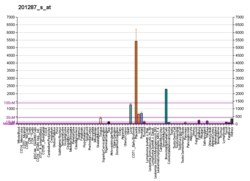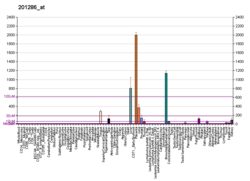Top Qs
Timeline
Chat
Perspective
Syndecan 1
Protein which in humans is encoded by the SDC1 gene From Wikipedia, the free encyclopedia
Remove ads
Syndecan 1 is a protein which in humans is encoded by the SDC1 gene.[5][6] The protein is a transmembrane (type I) heparan sulfate proteoglycan and is a member of the syndecan proteoglycan family. The syndecan-1 protein functions as an integral membrane protein and participates in cell proliferation, cell migration and cell-matrix interactions via its receptor for extracellular matrix proteins. Syndecan-1 is a sponge for growth factors and chemokines,[7] with binding largely via heparan sulfate chains. The syndecans mediate cell binding, cell signaling, and cytoskeletal organization and syndecan receptors are required for internalization of the HIV-1 tat protein.
Altered syndecan-1 expression has been detected in several different tumor types. Syndecan 1 can be a marker for plasma cells.
Remove ads
Structure
Summarize
Perspective
The syndecan-1 core protein consists of an extracellular domain which can be substituted with heparan sulfate and chondroitin sulfate glycosaminoglycan chains, a highly conserved transmembrane domain, and a highly conserved cytoplasmic domain, which contains two constant regions that are separated by a variable region.[8] The extracellular domain can be cleaved (shed) from the cell surface at a juxtamembrane site,[9] converting the membrane-bound proteoglycan into a paracrine effector molecule with roles in wound repair [10] and invasive growth of cancer cells.[11]
An exception is the prosecretory mitogen lacritin that binds syndecan-1 only after heparanase modification.[12][13] Binding utilizes an enzyme-regulated 'off-on' switch in which active epithelial heparanase (HPSE) cleaves off heparan sulfate to expose a binding site in the N-terminal region of syndecan-1's core protein.[12] Three SDC1 elements are required. (1) The heparanase-exposed hydrophobic sequence GAGAL that promotes the alpha helicity of lacritin's C-terminal amphipathic alpha helix form and likely binds to the hydrophobic face. (2) Heparanase-cleaved heparan sulfate that is 3-O sulfated.[13] This likely interacts with the cationic face of lacritin's C-terminal amphipathic alpha helix. (3) An N-terminal chondroitin sulfate chain that also likely binds to the cationic face. Point mutagenesis of lacritin has narrowed the ligation site.[13]
While several transcript variants may exist for this gene, the full-length natures of only two have been described to date. These two represent the major variants of this gene and encode the same protein.[14]
Remove ads
Inflammation
Syndecan-1 deficient mice show increased inflammation, which was attributed to an increased ICAM-1 and heparan sulfate-dependent recruitment of leukocytes (including neutrophils and dendritic cells)[15] to the inflamed endothelium.[16] This increase results in higher inflammatory responses and tissue damage in experimental models of contact dermatitis,[17] inflammation of the kidney,[18] myocardial infarction,[19] inflammatory bowel disease[20] and experimental autoimmune encephalomyelitis[21] In experimental colitis-induced colon carcinoma, syndecan-1 deficiency promotes tumor growth in an IL-6 / STAT-signaling-dependent manner.[22]
Remove ads
Clinical significance
Altered syndecan-1 expression has been detected in several different tumor types.[23][24] In breast cancer, syndecan-1 is up regulated and contributes to the cancer stem cell phenotype, which is linked to increased resistance to chemotherapy and radiation therapy [25][26][27]
It is a specific antigen on multiple myeloma cells.[28] Indatuximab ravtansine targets this protein.
Application
It is a useful marker for plasma cells,[29] but only if the cells tested are already known to be derived from blood.[30] For plasma cells, it usually stains intensely membranous, with or without associated diffuse weak cytoplasmic and/or Golgi staining.[31] Few cases show cytoplasmic granular staining, with or without associated Golgi staining.[31]
References
Further reading
Wikiwand - on
Seamless Wikipedia browsing. On steroids.
Remove ads






